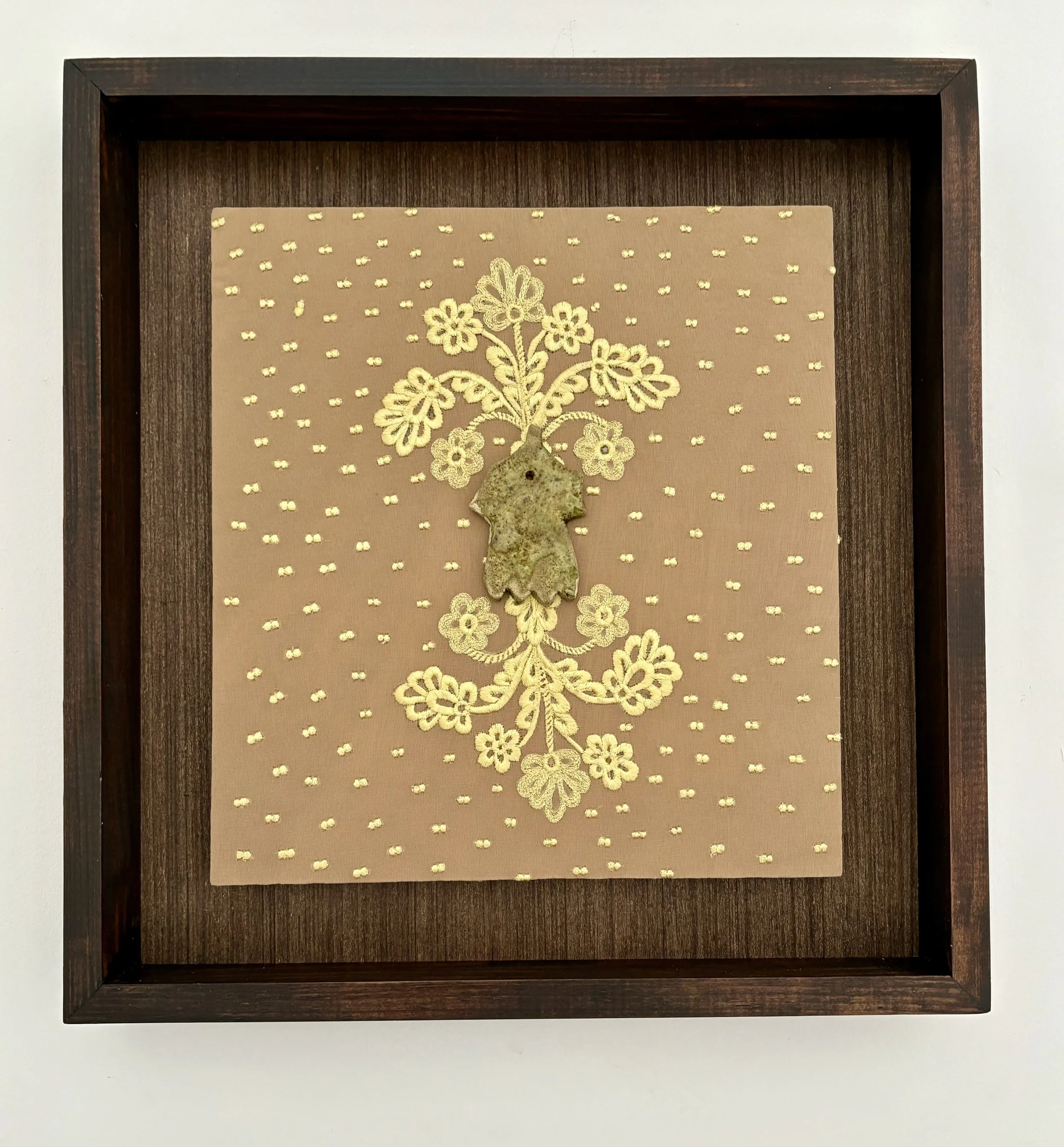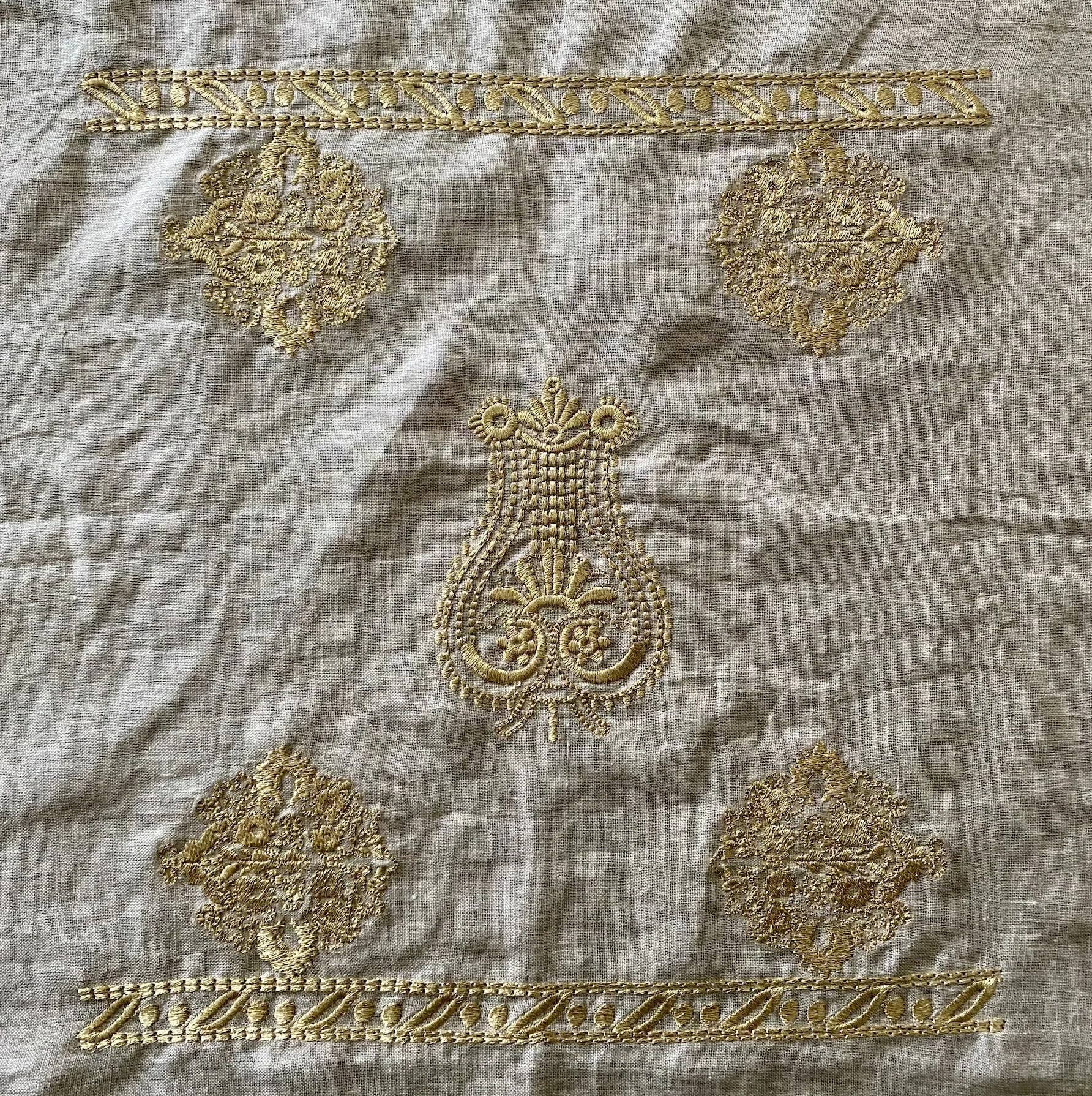Yeddin Studio is the work of artist Yasmine Lahjij. Her approach explores the confluence of cultures and their origins, reimagining symbols and harmonies. Spanning ceramic, drawing, and textile, her practice blends ancestral techniques with contemporary perspectives, and draws inspiration from North African, Roman, Iberian, and Greek traditions.
The studio operates on the principle that understanding the past cultivates innovative visions for the future. It encourages personal expression, reinforces community bonds, and promotes transmission of knowledge through art.
In the studio
Process and approach
Drawing inspiration from its base in the South of France, Yeddin Studio explores 17th-century Provençal prints and their Indian origins. Questioning appropriation through imitation, the project emphasises the superficial regard given to the original masters of block-printing.
Here, the work examines textile production as a space for counter-narratives, fostering an intimate link with the original Indian print. By embracing stitching as a means to weave an intimate dialogue and harmony, the design highlights the contrast between the original motif and the artist's needlework, paying tribute to the craft's legacy.
Drawing with a thread (Orange and beige Indienne) © 2025 by Yasmine Lahjij - Yeddin Studio is licensed under CC BY-SA 4.0
Inspired by beekeeping and the wisdom of plants, Yeddin's practice embraces a sensitivity to nature. This embroidery honours the brilliance of common herbs, like Ruta graveolens, revered since the Renaissance and known as "herb of grace" for its use in sacred rituals. Adorned with a small ceramic piece inspired by ancient mirrors held in the collection of Palazzo Altemps, Rome, this work-in-progress humbly celebrates the profound connection between humanity and the environment, revealing grace within simple botanical treasures.
Herb of Grace © 2025 by Yasmine Lahjij - Yeddin Studio is licensed under CC BY-SA 4.0
Yeddin Studio embraces foraging wild clay for its unique artworks, a deliberate departure from the conventional ceramic industry's dependence on resource-depleting clay quarries. The act of collecting local earth, hand-processing it, and firing it with wood represents a more thoughtful and rewarding approach, imbuing the work with a sense of place, connecting to local crafts and mindful creation.
Works
"Il colore della terra" presents a collection of four sculptures that blend ancient Roman forms, inspired by Piranesi's vase, with traditional Drâa Valley pottery. Crafted on a mechanical wheel using wild clay, the pieces are glazed in the signature colours of Tamegroute (green and ochre) and fired in a traditional kiln, incorporating elements like candle holders, textured edges, and simple bases.
Il colore della terra © 2024 by Yasmine Lahjij - Yeddin Studio is licensed under CC BY-NC-ND 4.0
The sculptures present a striking contrast between sleek shapes and textured surfaces, stemming from Tamegroute ceramic tradition. As in the Southern Moroccan pottery, what might be considered imperfections are intentionally embraced, adding to the vessel's unique character. Dimensions: circa 40 cm x 25 cm, 2024, unique pieces.
Il colore della terra © 2024 by Yasmine Lahjij - Yeddin Studio is licensed under CC BY-NC-ND 4.0
“Occhio Malocchio (uccellini)” showcases finely textured needlework steeped in history. The bird motif originates from the iconic Provençal boutis embroidery of the 18th century, a period renowned for its symbolic motifs. The framed piece features an eye-shaped amulet, handcrafted from wild clay and pit fired in Palombara Sabina, near Rome.
Dimensions: 43 x 31,3 x 4,5 cm, 2024, unique piece.
Occhio Malocchio (uccellini) © 2024 by Yasmine Lahjij - Yeddin Studio is licensed under CC BY-NC-ND 4.0
Deinanthe Capraggine (hamsa)
Embroidery on mousseline, glazed and wood fired wild clay from Tamegroute.
46 x 43 x 4,5 cm with frame, 2024, unique piece.
Deinanthe Capraggine (hamsa) © 2024 by Yasmine Lahjij - Yeddin Studio is licensed under CC BY-NC-ND 4.0
‘Tetouan to Provence’, 2024. Detail of an embroidery on linen designed for a custom DJ case.
A project weaving Provence boutis embroidery with traditional Tetouan tarz.
Tetouan to Provence © 2024 by Yasmine Lahjij - Yeddin Studio is licensed underCC BY-SA 4.0
Handcrafted in Lisbon, these amulets take the shapes of ancient Hamsa (Hand of Fatima). Inspired by Lisbon's traditional tiles (azulejos), the small ceramics blend geometric and botanical motifs, paying tribute to the city's Spanish-Moorish heritage and connecting to a long tradition of this symbolic craft. Each design holds irregularities, serving a personal interpretation of this enduring legacy and narrative.
‘Hamsa’, sandstone, ceramic pencil and matt enamel. Circa 7 x 11 cm each, 2023, unique pieces.
Hamsa © 2023 by Yasmine Lahjij - Yeddin Studio is licensed under CC BY-NC-ND 4.0
”Smoky”, coffee cups. Handmade with wild clay and pit fired in Palombara Sabina, Italy, 2023.
‘arusa di el shtaa’, golden ink on tissue paper, 44 x 37 cm, 2023.
arusa di el shtaa © 2023 by Yasmine Lahjij - Yeddin Studio is licensed under CC BY-NC-ND 4.0
´The Necessary Angel’
Wood burning, 27,5 x 26,5 cm, 2023.
The Necessary Angel © 2023 by Yasmine Lahjij - Yeddin Studio is licensed underCC BY-NC-ND 4.0
(…) Yet I am the necessary angel of earth,
Since, in my sight, you see the earth again,
Cleared of its stiff and stubborn, man-locked set,
And, in my hearing, you hear its tragic drone
Rise liquidly in liquid lingerings
Like watery words awash; like meanings said
By repetitions of half meanings. Am I not,
Myself, only half of a figure of a sort,
A figure half seen, or seen for a moment, a man
Of the mind, an apparition apparelled in
Apparels of such lightest look that a turn
Of my shoulder and quickly, too quickly, I am gone?
The Necessary Angel: Essays on Reality and the Imagination, Wallace Stevens, 1951.














